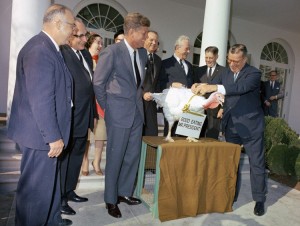Thanksgiving is Turkey Day
Thursday, November 24th, 2016November 24, 2016
In the United States, today, Thursday, November 24, is the annual holiday of Thanksgiving, a day for giving thanks and remembering the blessings of life. Across the country, families and friends gather together for dinners, good company, and—quite often—football games. The traditional centerpiece of a Thanksgiving dinner is a plump turkey cooked in the oven, on the grill, or even in a deep fryer. Many Americans take the table presence of this North American bird for granted. But have you ever wondered how it was that turkey became Thanksgiving’s traditional meal? There’s not one easy answer, but a few things led to the creation of “Turkey Day.”

President John F. Kennedy is presented with a Thanksgiving turkey in the Rose Garden of the White House on November 19, 1963. Kennedy pardoned the turkey, stating, “Let’s keep him going.” Credit: National Archives
Naturally, there are no menus around from that “first” Thanksgiving held by American Indians and the Plymouth Colony Pilgrims in 1621. We can guess, however, that early Thanksgiving foods may have included turkey as well as duck and venison (all plentiful in New England), along with traditional Native American foods such as nasaump (corn porridge) and a pumpkin dish called pompion.
Many communities, particularly in New England, began celebrating Thanksgiving in the 1700’s, and turkey was often the main course at the holiday dinner. In 1784, American patriot Benjamin Franklin suggested that the turkey—a “bird of courage”—was a more fitting national bird than the bald eagle. In the late 1790′s, another American patriot, Alexander Hamilton, supposedly said, “No citizen of the U.S. shall refrain from turkey on Thanksgiving Day.”
Thanksgiving became a national holiday in 1863, when magazine editor Sarah Josepha Hale persuaded President Abraham Lincoln of the holiday’s importance—particularly during the tough years of the American Civil War (1861-1865). Hale’s powers of persuasion also led to Thanksgiving tables weighted down by stuffed turkey. She described the dish as the “belle of the ball” and included recipes in her popular magazine, Godey’s Lady’s Book. In the following years, turkey became established as a Thanksgiving staple.
Because of their size, turkeys yield a large amount of meat per bird. So, large gatherings such as Thanksgiving are tailor-made for roast turkey. Chickens are too small for that, and chickens also provide valuable eggs. When was the last time you had turkey eggs for breakfast? And turkeys, particularly in their native North America, are relatively plentiful, whether in the wild or on a farm. Turkey dinners are also considered “appropriate” for special occasions (beef or pork often are not), which is why turkey is often the main course at Christmas, too. Flocks of turkeys were once driven to markets, often over long distances, like cattle herds. Many turkeys, then, simply walked to Thanksgiving dinner unaware they were to be the main course.
Each Thanksgiving since 1947, a live turkey or two has been presented to the president of the United States by the National Turkey Federation, a trade group representing the turkey industry. In the last 30 years or so, however, most presidential turkeys have been “pardoned,” and allowed to live out their somewhat natural lives. According to the White House Historical Association, in 1963, just days before he was assassinated, President John F. Kennedy became the first to pardon a presidential turkey.


